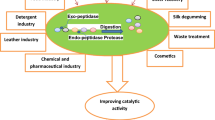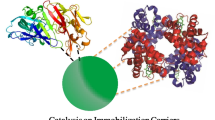Abstract
Hydrophobins are amphipathic secretory proteins with eight conserved cysteine residues and are ubiquitous among filamentous fungi. In the fungus Aspergillus oryzae, the hydrophobin RolA and the polyesterase CutL1 are co-expressed when the sole available carbon source is the biodegradable polyester polybutylene succinate-co-adipate (PBSA). RolA promotes the degradation of PBSA by attaching to the particle surface, changing its structure and interacting with CutL1 to concentrate CutL1 on the PBSA surface. We previously reported that positively charged residues in RolA and negatively charged residues in CutL1 are cooperatively involved in the ionic interaction between RolA and CutL1. We also reported that hydrophobin RodA of the model fungus Aspergillus nidulans, which was obtained via an A. oryzae expression system, interacted via ionic interactions with CutL1. In the present study, phylogenetic and alignment analyses revealed that the N-terminal regions of several RolA orthologs contained positively charged residues and that the corresponding negatively charged residues on the surface of CutL1 that were essential for the RolA–CutL1 interaction were highly conserved in several CutL1 orthologs. A PBSA microparticle degradation assay, a pull-down assay using a dispersion of Teflon particles, and a kinetic analysis using a quartz crystal microbalance revealed that recombinant A. nidulans RodA interacted via ionic interactions with two recombinant A. nidulans cutinases. Together, these results imply that ionic interactions between hydrophobins and cutinases may be common among aspergilli and other filamentous fungi.





Similar content being viewed by others
References
Bauer S, Vasu P, Persson S, Mort AJ, Somerville CR (2006) Development and application of a suite of polysaccharide-degrading enzymes for analyzing plant cell walls. Proc Natl Acad Sci U S A 103:11417–11422
Castro-Ochoa D, Peña-Montes C, González-Canto A, Alva-Gasca A, Esquivel-Bautista R, Navarro-Ocaña A, Farrés A (2012) ANCUT2, an extracellular cutinase from Aspergillus nidulans induced by olive oil. Appl Biochem Biotechnol 166:1275–1290
Chandra M, Kalra A, Sharma PK, Sangwan RS (2009) Cellulase production by six Trichoderma spp. fermented on medicinal plant processings. J Ind Microbiol Biotechnol 36:605–609
Corvis Y, Walcarius A, Rink R, Mrabet NT, Rogalska E (2005) Preparing catalytic surfaces for sensing applications by immobilizing enzymes via hydrophobin layers. Anal Chem 77:1622–1630
de Vocht ML, Scholtmeijer K, van der Vegte EW, de Vries OM, Sonveaux N, Wösten HAB, Ruysschaert JM, Hadziioannou G, Wessels JGH, Robillard GT (1998) Structural characterization of the hydrophobin SC3, as a monomer and after self-assembly at hydrophobic/hydrophilic interfaces. Biophys J 74:2059–2068
de Vries OMH, Fekkes MP, Wösten HAB, Wessels JGH (1993) Insoluble hydrophobin complexes in the walls of Schizophyllum commune and other filamentous fungi. Arch Microbiol 159:330–335
Deshpande N, Wilkins MR, Packer N, Nevalainen H (2008) Protein glycosylation pathways in filamentous fungi. Glycobiology 18:626–637
Espino-Rammer L, Ribitsch D, Przylucka A, Marold A, Greimel KJ, Herrero Acero E, Guebitz GM, Kubicek CP, Druzhinina IS (2013) Two novel class II hydrophobins from Trichoderma spp. stimulate enzymatic hydrolysis of poly(ethylene terephthalate) when expressed as fusion proteins. Appl Environ Microbiol 79:4230–4238
Fang X, Qiu F, Yan B, Wang H, Mort AJ, Stark RE (2001) NMR studies of molecular structure in fruit cuticle polyesters. Phytochemistry 57:1035–1042
Gomi K, Iimura Y, Hara S (1987) Integrative transformation of Aspergillus oryzae with a plasmid containing the Aspergillus nidulans argB Gene. Agri Biol Chem 51:2549–2555
Goto M (2007) Protein O-glycosylation in fungi: diverse structures and multiple functions. Biosci Biotechnol Biochem 71:1415–1427
Gouka RJ, Punt PJ, van den Hondel CAMJJ (1997) Efficient production of secreted proteins by Aspergillus: progress, limitations and prospects. Appl Microbiol Biotechnol 47:1–11
Green MR, Sambrook J (2012) Molecular cloning: a laboratory manual. Cold Spring Harbor Laboratory Press, New York
Hama H, Saito A, Takeda T, Tanuma A, Xie Y, Sato K, Kazama JJ, Gejyo F (2004) Evidence indicating that renal tubular metabolism of leptin is mediated by megalin but not by the leptin receptors. Endocrinology 145:3935–3940
Hata Y, Kitamoto K, Gomi K, Kumagai C, Tamura G (1992) Functional elements of the promoter region of the Aspergillus oryzae glaA gene encoding glucoamylase. Curr Genet 22:85–91
Ichishima E (2000) Unique catalytic and molecular properties of hydrolases from Aspergillus used in Japanese bioindustries. Biosci Biotechnol Biochem 64:675–688
Johnson M, Zaretskaya I, Raytselis Y, Merezhuk Y, McGinnis S, Madden TL (2008) NCBI BLAST: a better web interface. Nucleic Acids Res 1(36 (Web Server issue)):W5–W9. doi:10.1093/nar/gkn201
Larkin MA, Blackshields G, Brown NP, Chenna R, McGettigan PA, McWilliam H, Valentin F, Wallace IM, Wilm A, Lopez R, Thompson JD, Gibson TJ, Higgins DG (2007) ClustalW and ClustalX version 2. Bioinformatics 23:2947–2948
Liu Z, Gosser Y, Baker PJ, Ravee Y, Lu Z, Alemu G, Li H, Butterfoss GL, Kong XP, Gross R, Montclare JK (2009) Structural and functional studies of Aspergillus oryzae cutinase: enhanced thermostability and hydrolytic activity of synthetic ester and polyester degradation. J Am Chem Soc 131:15711–15716
Machida M, Yamada O, Gomi K (2008) Genomics of Aspergillus oryzae: learning from the history of Koji mold and exploration of its future. DNA Res 15:173–183
Maeda H, Yamagata Y, Abe K, Hasegawa F, Machida M, Ishioka R, Gomi K, Nakajima T (2005) Purification and characterization of a biodegradable plastic-degrading enzyme from Aspergillus oryzae. Appl Microbiol Biotechnol 67:778–788
Maley F, Trimble RB, Tarentino AL, Plummer TH Jr (1989) Characterization of glycoproteins and their associated oligosaccharides through the use of endoglycosidases. Anal Biochem 180:195–204
Martins I, Hartmann DO, Alves PC, Martins C, Garcia H, Leclercq CC, Ferreira R, He J, Renaut J, Becker JD, Pereira CS (2014) Elucidating how the saprophytic fungus Aspergillus nidulans uses the plant polyester suberin as carbon source. BMC Genomics 15:613. doi:10.1186/1471-2164-15-613
Nishimura M, Fukada J, Moriwaki A, Fujikawa T, Ohashi M, Hibi T, Hayashi N (2009) Mstu1, an APSES transcription factor, is required for appressorium-mediated infection in Magnaporthe grisea. Biosci Biotechnol Biochem 73:1779–1786
Ohtaki S, Maeda H, Takahashi T, Yamagata Y, Hasegawa F, Gomi K, Nakajima T, Abe K (2006) Novel hydrophobic surface binding protein, HsbA, produced by Aspergillus oryzae. Appl Environ Microbiol 72:2407–2413
Ollis DL, Cheah E, Cygler M, Dijkstra B, Frolow F, Franken SM, Harel M, Remington SJ, Silman I, Schrag J, Sussman JL, Verschueren KHG, Goldman A (1992) The alpha/beta hydrolase fold. Protein Eng 5:197–211
Papworth C, Bauer JC, Braman J, Wright DA (1996) Site-directed mutagenesis in one day with >80% efficiency. Strategies 9:3–4
Pham CL, Rey A, Lo V, Soulès M, Ren Q, Meisl G, Knowles TP, Kwan AH, Sunde M (2016) Self-assembly of MPG1, a hydrophobin protein from the rice blast fungus that forms functional amyloid coatings, occurs by a surface-driven mechanism. Sci Rep 6:25288–25303
Purdy RE, Kolattukudy PE (1975) Hydrolysis of plant cuticle by plant pathogens. Properties of cutinase I, cutinase II, and a nonspecific esterase isolated from Fusarium solani pisi. Biochemistry 14:2832–2840
Ribitsch D, Herrero Acero E, Przylucka A, Zitzenbacher S, Marold A, Gamerith C, Tscheließnig R, Jungbauer A, Rennhofer H, Lichtenegger H, Amenitsch H, Bonazza K, Kubicek CP, Druzhinina IS, Guebitz GM (2015) Enhanced cutinase-catalyzed hydrolysis of polyethylene terephthalate by covalent fusion to hydrophobins. Appl Environ Microbiol 81:3586–3592
Scholtmeijer K, de Vocht ML, Rink R, Robillard GT, Wösten HAB (2009) Assembly of the fungal SC3 hydrophobin into functional amyloid fibrils depends on its concentration and is promoted by cell wall polysaccharides. J Biol Chem 284:26309–26314
Skamnioti P, Gurr SJ (2008) Cutinase and hydrophobin interplay: a herald for pathogenesis? Plant Signal Behav 3:248–250
Sweigard JA, Chumley FG, Valent B (1992) Cloning and analysis of CUT1, a cutinase gene from Magnaporthe grisea. Mol Gen Genet 232:174–182
Takahashi T, Maeda H, Yoneda S, Ohtaki S, Yamagata Y, Hasegawa F, Gomi K, Nakajima T, Abe K (2005) The fungal hydrophobin RolA recruits polyesterase and laterally moves on hydrophobic surfaces. Mol Microbiol 57:1780–1796
Takahashi T, Tanaka T, Tsushima Y, Muragaki K, Uehara K, Takeuchi S, Maeda H, Yamagata Y, Nakayama M, Yoshimi A, Abe K (2015) Ionic interaction of positive amino acid residues of fungal hydrophobin RolA with acidic amino acid residues of cutinase CutL1. Mol Microbiol 96:14–27
Tanaka T, Tanabe H, Uehara K, Takahashi T, Abe K (2014) Involvement of hydrophobic amino acid residues in C7-C8 loop of Aspergillus oryzae hydrophobin RolA in hydrophobic interaction between RolA and a polyester. Biosci Biotechnol Biochem 78:1693–1699
Tani S, Katsuyama Y, Hayashi T, Suzuki H, Kato M, Gomi K, Kobayashi T, Tsukagoshi N (2001) Characterization of the amyR gene encoding a transcriptional activator for the amylase genes in Aspergillus nidulans. Curr Genet 39:10–15
Wang C, St Leger RJ (2005) Developmental and transcriptional responses to host and nonhost cuticles by the specific locust pathogen Metarhizium anisopliae var. acridum. Eukaryot Cell 4:937–947
Wang Z, Lienemann M, Qiau M, Linder MB (2010) Mechanisms of protein adhesion on surface films of hydrophobin. Langmuir 26:8491–8496
Wessels J, De Vries O, Asgeirsdottir SA, Schuren F (1991) Hydrophobin genes involved in formation of aerial hyphae and fruit bodies in schizophyllum. Plant Cell 3:793–799
Wessels JGH (1994) Developmental regulation of fungal cell wall formation. Annu Rev Phytopathol 32:413–437
Wösten HAB (2001) Hydrophobins: multipurpose proteins. Annu Rev Microbiol 55:625–646
Wösten HAB, van Wetter MA, Lugones LG, van der Mei HC, Busscher HJ, Wessels JGH (1999) How a fungus escapes the water to grow into the air. Curr Biol 9:85–88
Yoon J, Kimura S, Maruyama J, Kitamoto K (2009) Construction of quintuple protease gene disruptant for heterologous protein production in Aspergillus oryzae. Appl Microbiol Biotechnol 82:691–701
Acknowledgements
We thank Du Pont-Mitsui Fluorochemicals Co., Ltd. for the gift of the Teflon PFA350 suspension. We thank Katsuhiko Kitamoto of the University of Tokyo for providing the Aspergillus oryzae NSlD-tApEnBdIVdV2. We thank Hiroyuki Horiuchi of the University of Tokyo for providing the pUCpyroA2. We thank Daiki Sato, Megumi Nagayama, Yoonkyung Kim, Yuki Terauchi, Naoki Abe, and Natsumi Okada for helpful discussions and technical assistance.
Author information
Authors and Affiliations
Corresponding author
Ethics declarations
Funding
This work was supported, in part, by KAKENHI (Japan Society for the Promotion of Science), a Grant-in-Aid for Scientific Research (B) (grant no. 20380175 to Keietsu Abe), and a Challenging Exploratory Research grant (grant no. 24658281 to Keietsu Abe). This work was also supported, in part, by Japan Society for the Promotion of Science (JSPS) Research Fellowships for Young Scientists (grant no. 15J01183 to Takumi Tanaka).
Conflict of interest
The authors declare that they have no conflict of interests.
Ethical approval
This article does not contain any studies with human participants or animals performed by any of the authors.
Electronic supplementary material
ESM 1
(PDF 4.29 mb)
Rights and permissions
About this article
Cite this article
Tanaka, T., Nakayama, M., Takahashi, T. et al. Analysis of the ionic interaction between the hydrophobin RodA and two cutinases of Aspergillus nidulans obtained via an Aspergillus oryzae expression system. Appl Microbiol Biotechnol 101, 2343–2356 (2017). https://doi.org/10.1007/s00253-016-7979-5
Received:
Revised:
Accepted:
Published:
Issue Date:
DOI: https://doi.org/10.1007/s00253-016-7979-5




